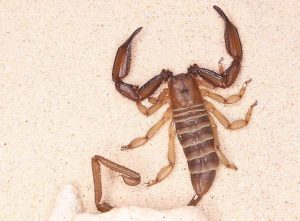What our expert says
Animal Scene solicited the opinions of John Valentin Chua, who shared many excellent sources (please see end of article) for keepers and fanciers to explore.
He says the Hadogenes paucidens, more commonly known as the banded flat rock scorpion, grows from 5 – 5.5 (and occasionally bigger) inches. They are considered medium to large scorpions. You can expect it to have a lifespan of 30 years.
What’s the secret of its appeal then? “Its colors and its size [are] what [make] this scorpion a must-have; however, it is very rare and expensive in the Philippines,” says John.
Imported from Africa, it’s most often found in Southern Africa (particularly South Africa, Zimbabwe, Mozambique, Tanzania, Namibia, and so on). They are considered a semi-desert species. Thus they are at home in dry, sandy soil, and they don’t burrow.
John believes the Hadogenes paucidens is good for beginners. “It’s skittish and harmless unless you’re a bug,” he jokes. He adds that it’s easy to keep. “Just Google the temperature [of the] country they come from.”
When it comes to their enclosure, “Due to their large size, I would suggest an enclosure of 14’’ x 10’’ x 10’’ as a minimum for an adult (possibly larger for an adult male H. troglodytes). This will allow plenty of space to create the correct hides/habitat within. Plain glass aquariums with a lid or all glass vivariums with hinged doors [such as Exo Terras] are perfect.” In the enclosure, “I provide a small dish of water once every week or two and allow it to dry out.”
As for housing, John advises that the substrate you use be cocopeat brick (available at Ace Hardware). He also suggests that you add some flat rocks for your banded flat rock scorpion to hide under. Humidity is best kept at 50 percent as they don’t like humid enclosures; expert keepers share that they don’t use water dishes, and seem to benefit more from a once-weekly misting of their enclosure with water.
John quotes one of his favorite sources, who shares: “Flat rock scorpions are shy, skittish animals that prefer to flee and hide rather than face a potential threat…Mine will react to even the slightest vibrations, such as someone walking about in another room, and will immediately reverse back into its hide until it feels the ‘threat’ has gone.” (Additional text by Animal Scene)
This appeared in Animal Scene magazine’s November 2017 issue.




